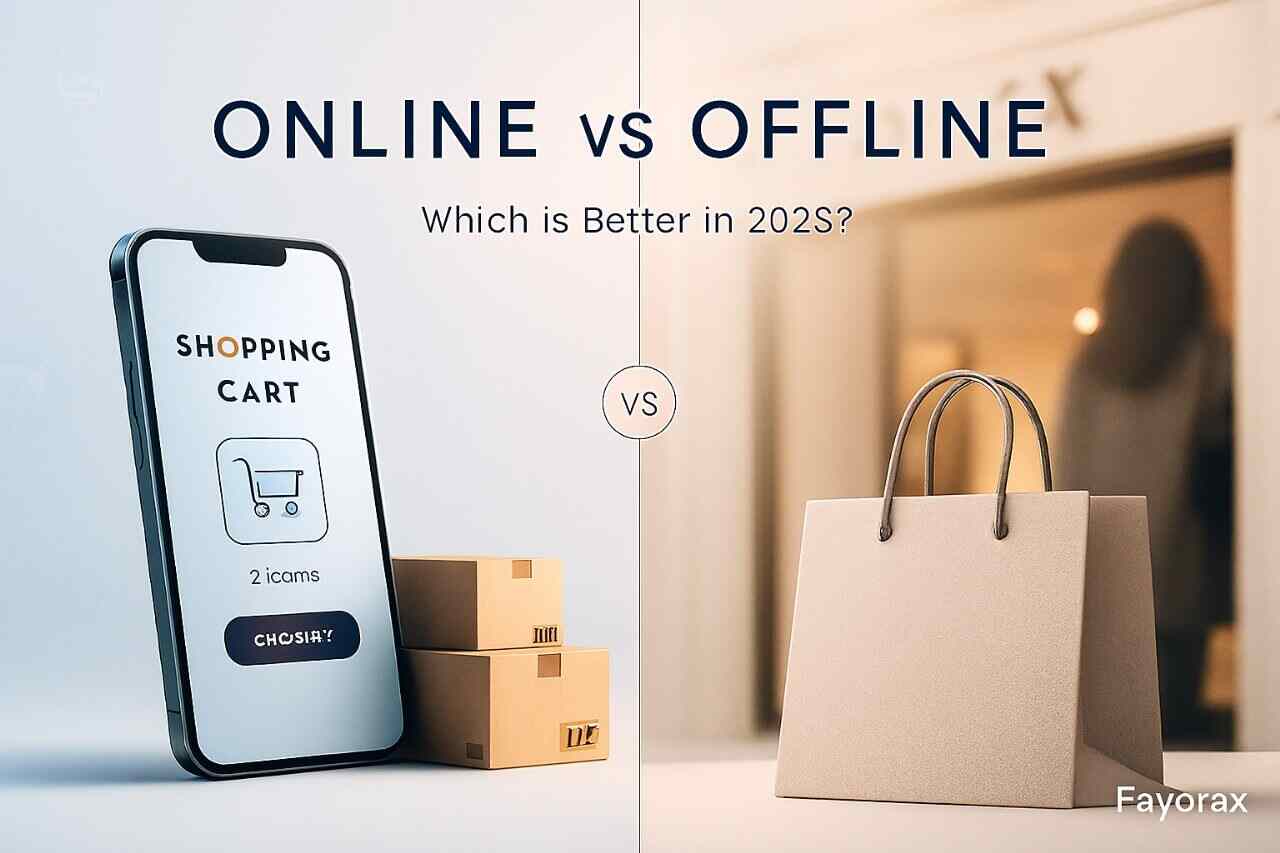We independently review everything we recommend. When you buy through our links, we may earn a commission. Learn more
Online Shopping vs Offline Shopping: Which Is Better in 2025?

Last updated 2nd October 2025
Shopping in India has evolved tremendously over the past decade. In 2025, both online shopping and offline (in-store) shopping are strong contenders for consumer attention. While e-commerce promises convenience and variety, physical stores offer tangible experience and immediate gratification. The choice often depends on what you value most.
In this comparison guide, we’ll dig deep into both modes: their advantages, disadvantages, trends, and how to decide which is better for you in 2025. Along the way, we’ll refer to useful reviews and guides on Fayorax to add value to your decision-making.
The Rise of Online Shopping in India
Online shopping in India isn’t new — but its speed and scale have exploded. Smartphones, improved internet connectivity, and logistics infrastructure have turned many first-time offline shoppers into habitual online buyers.
Key Drivers of Online Shopping Growth
- 24/7 access: You can shop anytime and anywhere.
- Vast Catalogs: Access to thousands of products, brands, and variants that physical stores may not stock.
- Deals & Discounts: Online platforms frequently run flash sales, coupons, cashback, and exchange offers.
- Convenience: Delivery to your doorstep — no need to travel or carry items.
- Easy Comparisons & Reviews: You can read specs, user reviews, and compare side by side in seconds.
For example, tech buyers often consult deep comparison content like our Intel vs AMD laptop processor guide before pulling the trigger on a purchase. That kind of decision-making is much easier online than in-store.
Why Offline Shopping Still Matters
Despite its growth, offline retail remains highly relevant — especially in India. For many categories, the experience of touching, testing, and interacting in person is still unmatched.
Strengths of Offline Shopping
- Sensory Experience: You can see, touch, smell, or try a product before buying — important for clothing, perfumes, and accessories.
- Instant Ownership: You take your purchase home immediately.
- Personal Assistance: Sales personnel can answer questions, suggest options, and guide you in real time.
- Trust Factor: Especially for high-value or luxury products, in-person inspection builds confidence.
- Social & Emotional Value: Shopping trips are experiences with family or friends, often combined with leisure activities.
Consider a luxury perfume purchase: smelling it in person and getting direct advice is often more reassuring than trusting just photos and descriptions.
Side-by-Side Comparison: Online vs Offline
| Factor | Online Shopping | Offline (In-store) Shopping |
|---|---|---|
| Access & Timing | Shop anytime from home | Bound by store hours and location |
| Product Range | Huge variety, niche items, global brands | Limited to what the store stocks |
| Pricing & Offers | Many promos, bundles, exchange offers | Discounts, seasonal sales, bargaining in local markets |
| Delivery / Possession | You wait for delivery; shipping time & costs apply | You get it immediately at point of sale |
| Returns & Refunds | Return windows, pick-up logistics, delays possible | Often immediate exchanges or in-store resolution |
| Trust & Authentication | Depends on seller reputation, reviews, platform safeguards | You can directly inspect product quality and packaging |
| Support & Assistance | Chatbots, support lines, product descriptions | Face-to-face staff help, demonstrations |
| Shopping Experience | Private, efficient, minimal social interaction | Social, immersive, part of outing or leisure |
Common Advantages of Online Shopping
-
Convenience Above All
Whether you're working late or at home, you can browse and buy without leaving your couch. -
Broader Choice & Availability
Many brands or variants are only sold online; niche and imported items are more accessible. -
Price Transparency & Comparison Tools
You can quickly compare multiple sellers for the best deal. -
Frequent Offers & Cashbacks
Big sale days, coupon stacking, pandemic-era buying behavior have made online offers aggressive. -
Home Delivery & Cashless Payments
Payment via wallet, UPI, card, and returns handled by the seller or courier.
Common Advantages of Offline Shopping
-
Tangible Experience
You can test, try on, and inspect products physically which reduces risk. -
Immediate Satisfaction
No waiting – you walk out with your purchase. -
Face-to-Face Service
Store staff can guide, suggest alternatives, and tailor service to you. -
No Shipping Hassles
No waiting for delivery windows, no lost or damaged shipments in transit. -
Local Market Deals & Negotiation
You may negotiate or get bundle discounts in local stores.
Key Challenges & Risks to Consider
Online Shopping Risks
- Counterfeits & frauds: Not all sellers are trustworthy.
- Delivery delays or damage: Logistics can fail.
- Return hassle: Some platforms have strict or cumbersome return policies.
- Hidden costs: Delivery charges or import duties might nullify the discount.
Offline Shopping Risks
- Limited selection: The store might not carry what you want.
- Overpricing: Local shops may charge premiums for convenience.
- Impulse buying: The environment may push you to spend more.
- Time cost: Travel, parking, and waiting in queues.
Which Products Are Better Bought Online in 2025?
Some categories clearly prefer online channels in the modern era:
- Electronics & Gadgets: Deep specifications, global variants, and price comparison help.
- Books & Media: Rare editions, fast delivery.
- Fashion & Accessories: Especially basic clothing, shoes, or items with good return policies.
- Beauty & Grooming: Wide range of brands and user reviews.
- Home & Kitchen: Appliances and tools that are bulky in-store.
To see examples and curated picks across several categories, check out the Fayorax product categories section.
Which Products Are Better Bought Offline?
Certain items still demand an in-person presence:
- Luxury perfumes & fragrance: You want to test and experience scent before committing.
- Jewellery: Eye inspection, weight, shine, and authenticity matter.
- Custom clothing & traditional wear: Sarees, garments needing tailoring or draping.
- Perishables & fresh produce: You want to feel and pick freshness.
For instance, you might read reviews of tech devices online, like the ASUS Vivobook 15 review, but test the Laptop section in-store before buying.
Hybrid Models & the Future of Shopping
In 2025, “pure” online or offline is less common. Blended or omni-channel models are thriving:
-
Click-and-collect / Buy-online-pickup-in-store (BOPIS)
Order online, pick it up at a nearby physical store. -
Try-before-you-buy / Virtual try-on
Augmented Reality (AR) lets you test clothes or makeup before ordering. -
Showrooms / Experience zones
Physical spaces where you try items but complete purchases online for better deals.
This hybrid approach harnesses the best of both worlds: online convenience with offline trust and experience.
How to Decide: Online or Offline?
Here are guiding questions to help you choose:
-
Is this a product you want to test physically?
If yes (perfume, jewellery), prefer offline or hybrid. -
Can you find it online with trustworthy reviews and seller reputation?
If yes, online gives more variety and deals. -
How urgent is your need?
If you need something immediately, offline wins. -
Are you price-sensitive?
Online often offers better net pricing after discounts. -
Do you want zero risk?
Offline lets you visually inspect before buying.
Real-World Use Cases
- A student wants a tech laptop: they compare processors online (e.g. Intel vs AMD) and then test it in a store before purchase.
- Someone wants a perfume: they try samples offline, then may order bulk or refill online from a trusted shop.
- For clothes: they try in-store, choose sizes, and then order a cheaper color variant online.
This is how modern consumers behave — research online, experience offline, then buy whichever route gives the best value and assurance.
Final Thoughts: Which Is Better in 2025?
There’s no definitive winner. The best approach is flexibility. Use online shopping for convenience, variety, and price discovery. Use offline or hybrid formats for critical sensory purchases and instant gratification.
For deeper comparisons, product reviews, and buying advice on tech, fashion, accessories, and more, explore the Fayorax Articles & Guides. And if you want a central hub of shopping selections, reviews, and comparisons, start at the Fayorax Online Shopping Store.
In 2025, the smartest shoppers combine both — click when smart, walk into a store when needed.
Published 2nd October 2025
About the Author

Sahed Badsha | Technical Writer
Hi, I’m Sahed a professional blogger and content strategist focused on technology, products, and digital innovation. I specialize in writing clear, research-backed articles that simplify complex topics for everyday readers. Over the years, I’ve worked on blogs, product reviews that help readers make smarter digital choices while staying informed about emerging product trends.
